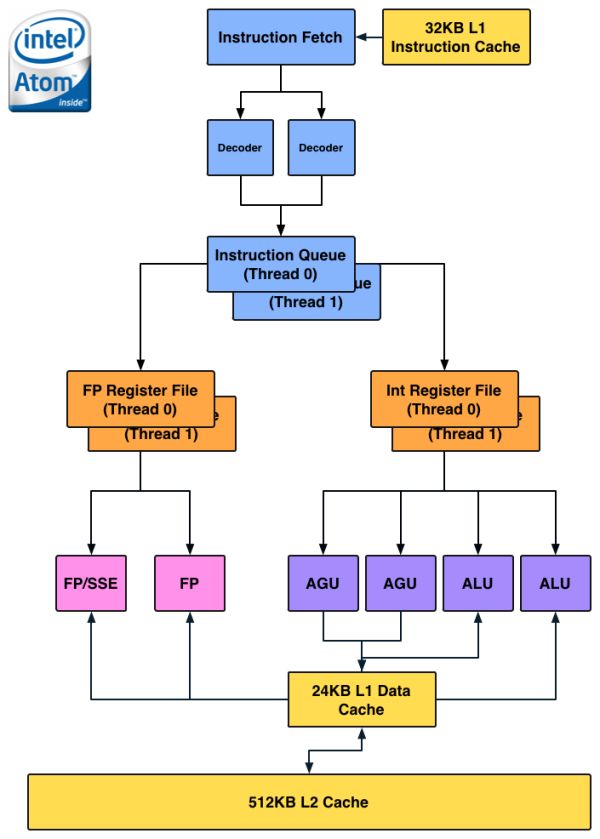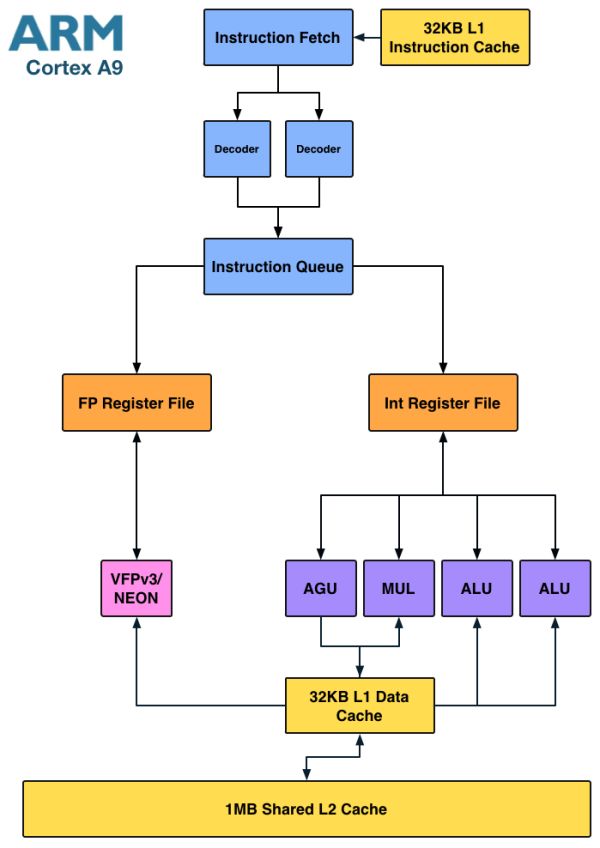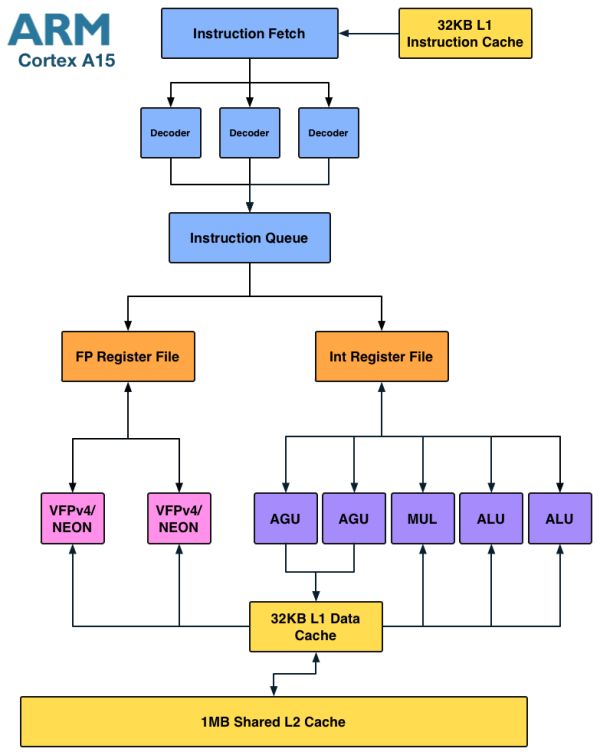Intel's Medfield & Atom Z2460 Arrive for Smartphones: It's Finally Here
by Anand Lal Shimpi on January 10, 2012 8:00 PM ESTThe CPU
Medfield is the platform, Penwell is the SoC and the CPU inside Penwell is codenamed Saltwell. It's honestly not much different than the Bonnell core used in the original Atom, although it does have some tweaks for both power and performance.
Almost five years ago I wrote a piece on the architecture of Intel's Atom. Luckily (for me, not Intel), Atom's architecture hasn't really changed over the years so you can still look back at that article and have a good idea of what is at the core of Medfield/Penwell. Atom is still a dual-issue, in-order architecture with Hyper Threading support. The integer pipeline is sixteen stages long, significantly deeper than the Cortex A9's. The longer pipeline was introduced to help reduce Atom's power consumption by lengthening some of the decode stages and increasing cache latency to avoid burning through the core's power budget. Atom's architects, similar to those who worked on Nehalem, had the same 2:1 mandate: every new feature added to the processor's design had to deliver at least a 2% increase in performance for every 1% increase in power consumption.
Atom is a very narrow core as the diagram below will show:
There are no dedicated integer multiply or divide units, that's all shared with the FP hardware. Intel duplicated some resources (e.g. register files, queues) to enable Hyper Threading support, but stopped short of increasing execution hardware to drive up efficiency. The tradeoff seems to have worked because Intel is able to deliver performance better than a dual-core Cortex A9 from a single HT enabled core. Intel also lucks out because while Android is very well threaded, not all tasks will continually peg both cores in a dual-core A9 machine. At higher clock speeds (1.5GHz+) and with heavy multi-threaded workloads, it's possible that a dual-core Cortex A9 could outperform (or at least equal) Medfield but I don't believe that's a realistic scenario.
Architecturally the Cortex A9 doesn't look very different from Atom:
Here we see a dedicated integer multiply unit (shared with one of the ALU ports) but only a single port for FP/NEON. It's clear that the difference between Atom and the Cortex A9 isn't as obvious at the high level. Instead it's the lower level architectural decisions that gives Intel a performance advantage.
Where Intel is in trouble is if you look at the Cortex A15:
The A15 is a far more modern design, also out of order but much wider than A9. I fully expect that something A15-class can outperform Medfield, especially if the former is in a dual-core configuration. Krait falls under the A15-class umbrella so I believe Medfield has the potential to lose its CPU performance advantage within a couple of quarters.
Enhancements in Saltwell
Although the CPU core is mated to a 512KB L2 cache, there's a separate 256KB low power SRAM that runs on its own voltage plane. This ULP SRAM holds CPU state and data from the L2 cache when the CPU is power gated in the deepest sleep state. The reasoning for the separate voltage plane is simple. Intel's architects found that the minimum voltage for the core was limited by Vmin for the ULP SRAM. By putting the two on separate voltage planes it allowed Intel to bring the CPU core down to a lower minimum power state as Vmin for the L2 is higher than it is for the CPU core itself. The downside to multiple power islands is an increase in die area. Since Medfield is built on Intel's 32nm LP process while the company transitions to 22nm, spending a little more on die area to build more power efficient SoCs isn't such a big deal. Furthermore, Intel is used to building much larger chips, making Medfield's size a relative nonissue for the company.
The die size is actually very telling as it's a larger SoC than a Tegra 2 with two Cortex A9s despite only featuring a single core. Granted the rest of the blocks around the core are different, but it goes to show you that the CPU core itself (or number of cores) isn't the only determination of the die size of an SoC.
The performance tweaks come from the usual learnings that take place over the course of any architecture's lifespan. Some instruction scheduling restrictions have been lifted, memory copy performance is up, branch predictor size increased and some microcode flows run faster on Saltwell now.
Clock Speeds & Turbo
Medfield's CPU core supports several different operating frequencies and power modes. At the lowest level is its C6 state. Here the core and L2 cache are both power gated with their state is saved off in a lower power on-die SRAM. Total power consumption in C6 of the processor island is effectively zero. This isn't anything new, Intel has implemented similar technologies in desktops since 2008 (Nehalem) and notebooks since 2010 (Arrandale).
When the CPU is actually awake and doing something however it has a range of available frequencies: 100MHz all the way up to 1.6GHz in 100MHz increments.
The 1.6GHz state is a burst state and shouldn't be sustained for long periods of time, similar to how Turbo Boost works on Sandy Bridge desktop/notebook CPUs. The default maximum clock speed is 1.3GHz, although just as is the case with Turbo enabled desktop chips, you can expect to see frequencies greater than 1.3GHz on a fairly regular basis.
Power consumption along the curve is all very reasonable:
| Medfield CPU Frequency vs. Power | ||||||
| 100MHz | 600MHz | 1.3GHz | 1.6GHz | |||
| SoC Power Consumption | ~50mW | ~175mW | ~500mW | ~750mW | ||
Since most ARM based SoCs draw somewhere below 1W under full load, these numbers seem to put Medfield in line with its ARM competitors - at least on the CPU side.
It's important to pay attention to the fact that we're dealing with similar clock frequencies to what other Cortex A9 vendors are currently shipping. Any performance advantages will either be due to Medfield boosting up to 1.6GHz for short periods of time, inherently higher IPC and/or a superior cache/memory interface.













164 Comments
View All Comments
Penti - Wednesday, January 11, 2012 - link
And it doesn't matter since the SoC's or rather CPU's aimed at Windows x86/64 tablets and Windows appliances does have SGX545. Windows 8 and Windows Phone (CE based) are two totally different OS's any way and Windows Phone is having a hard time just to support Qualcomm Snapdragon S1 and S2. I don't want to run Windows 8 Ribbon/MFC/WPF software on a phone platform neither do you. Microsoft won't support Windows Phone on x86. Microsoft won't support Windows 8 on this.They will as in Microsoft on Cedar Trail-M if PowerVR and Intel which have to ship them ever get their poor Windows drivers working. PowerVR/ImgTec aren't known for their Windows driver quality.
In a tablet and even tablet-PC (which Microsoft is still going for) it's mostly the screen that uses power. It doesn't matter if the cpu and chipset uses the 5W TDP plus 2.1W TDP it's still more power efficient then anything else running Windows (NT). It's just a few watts and a screen that will use just as much if not more power. In a phone on the other hand you can't have massive batteries and screens.
Intel is aiming the SoC towards Android handsets and tablets i.e. pads not tablet-pcs. They don't list DX support or even Windows Embedded support. Neither does it support more then 1GB of ram. It's built to interface with modem (baseband), LPDDR2, HDMI, MIPI-DSI, USB Phy, eMMC, with camera modules not with ordinary PC hardware topology of DDR3, PCI-e, LVDS/eDP, South bridge chipsets containing basic I/O. As well as support for USB, ethernet, SATA and whatnot in the SB. Memory will come included in the package too. Simply another platform.
Not for powering Office 2010 and Visual Studio 2012. Look for other chips there.
MySchizoBuddy - Tuesday, January 10, 2012 - link
This would be very interesting if it is launched TODAY not end of year.tipoo - Tuesday, January 10, 2012 - link
Yeah, that's why I'm wondering how it will perform against chips its actually going to compete with, namely Cortex A15 designs. The gap here is pretty big, but not insurmountable I think, and the A15 looks promising as well.tipoo - Tuesday, January 10, 2012 - link
Colour me impressed! This looks like it will be a rather disruptive SoC, especially with ARM Binary Translation. The nice thing is its a single core so developers don't have to optimize for two or four cores to get maximum performance. Although, I wonder if something like the quad core Tegra 3 would be able to best its performance if everything was more optimized for multicore? And more importantly, how will it fare against Cortex A15 designs. But, yeah, I'm excited for this, even more so for the variant with the 543MP2.Morg. - Thursday, January 12, 2012 - link
ARM binary translation will be slow ... like real slow.It's like a VM but on a different arch.
The tegra3 is just slightly slower .. on 40nm
Against A9 on the same process, ARM wins, against A15 ARM butchers.. nothing really different in the end - just that Intel can only count on process advantage to keep more or less in the race (so far).
milli - Tuesday, January 10, 2012 - link
Jason, yes I'm talking to you Jason Mick: oh how much you look like a fool now. Many people (including me) tried to warn you about your wrong article.DigitalFreak - Tuesday, January 10, 2012 - link
Wrong site, foo.Iketh - Tuesday, January 10, 2012 - link
I was thinking about that the entire time I was reading this.bji - Thursday, January 12, 2012 - link
What are you guys talking about?mikeepu - Thursday, January 12, 2012 - link
At first i thought the same thing as DigitalFreak, but i thought about it and went back to Jason Mick's article last month http://tinyurl.com/JasonMicksMedfieldArticle and found your comment. Yes. Yes, you did.